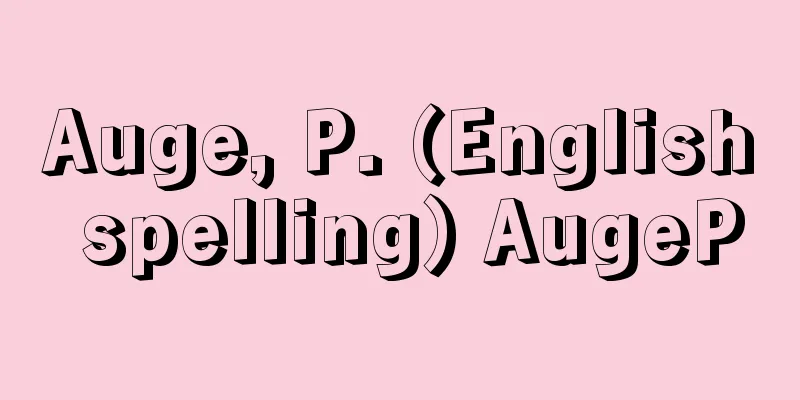Comedy

|
It is a translation of the words comedy (English), comédie (French) and Lustspiel (German). The word comedy comes from the ancient Greek komoidía, a compound word of komos, meaning "festival procession," and oide, meaning "song." Aristotle also introduces the theory that it is a compound word of the Doric word kome, meaning "village," in his Poetics, but classical scholars today do not accept this. However, Aristotle's description that comoidía originates from a phallic worship song is generally accepted. Since the Renaissance, the word comedy has often been applied to literary genres other than drama, such as Dante's Divine Comedy (Divina Commedia), and has been used to refer not only to comedies but also to drama in general, such as the Comédie Française, the national theater of France. [Mori Mitsuya] Definition of ComedySince there is no theory that can serve as the basis for the formation of comedy theory, such as Aristotle's theory of tragedy in Poetics, the definition of comedy is unclear. Aristotle, in contrast to tragedy, states that comedy depicts people who are inferior to those around us, and that their ugliness and humour are not of a nature to cause us pain. This fits with the definition of comedy that has been common since the Renaissance, which is that comedy reflects everyday life and ends happily ever after. Most happy endings are in the form of a marriage between a man and woman who are in love with each other, but in accordance with the cultural anthropological perspective since the end of the 19th century, many see traces of ancient rituals in this. In other words, comedy is a dramatization of the part of the ritual to celebrate the death and resurrection of the "Spirit of the Year" (marriage that brings about the birth of life). In terms of dramatic effect, it was a common argument among comedians that negative characters were the object of laughter in order to educate the audience, but in modern times, the social utility of comedy as a form of pure entertainment has also been recognized. This is in line with the evolution of the theory of "laughter." The view that laughter is caused by a sense of superiority has changed since the end of the 18th century to one that sees the incentive for laughter in the dissonance of the subject. However, when discussing the literary quality of a comedy, emphasis is placed on the expression of the author's "comic spirit," so to speak. The uniqueness of comedy is seen in the irony praised in the Romantic view of art since the late 18th century, in modern social criticism, and in the expression of the grotesqueness and absurdity of the contemporary world. This also leads to an evaluation of the lineage of tragicomedy. However, while a good tragedy always has literary value, a comedy can also be made excellent by the uniqueness of its performance form. One cause of confusion in comedy theory may be the confusion between "comic elements" and "comic themes." [Mori Mitsuya] Types of ComedyIn terms of the emphasis on comedic elements, farce, which is based on humorous conversations and actions, vaudeville, which features skits with songs, opera comique, which places emphasis on song and dance, burlesque, interludes, slapstick comedy, and even Japanese manzai and rakugo could all be placed in the category of comedy. In terms of the content of the plays, they are classified into comedies of character, which depict the unique personalities of the characters, comedies of manners, which focus on the humor of social customs and the behavior of characters, comedies of intrigue, and satirical comedies, which satirize real people and society, but all of these are just convenient names. However, the term comedy of manners is sometimes used to specifically refer to plays from the Restoration period in England in the 17th and 18th centuries, and similarly, the human interest dramas that were popular in 18th century France are called comédie larmoyante. Modern tragicomedies are also sometimes called black (dark) comedy or absurd drama. [Mori Mitsuya] History of Western ComedyThe history of Western theater is generally considered to have begun in Athens (Athens) in ancient Greece, but little is known about the origins of comedy beyond Aristotle's description that its origins lie in the phallic worship songs that took place in festival processions. The works of Aristophanes (c. 448 BC - c. 380 BC), the oldest surviving comic playwright, were focused on satire, humor, and the expression of the author's opinions, but by the time of Menander (c. 342 BC - c. 292 BC), the New Comedy was centered on the plot and had lost all social criticism. In the Roman era, Plautus (c. 254 BC - 184 BC) and Terence (c. 195 BC - 159 BC) made their mark with their adaptations of Greek New Comedy, influencing later generations. Medieval religious dramas can be said to be based on a comical worldview in that they anticipate salvation through Christ, but near the Renaissance, masterpieces of farce such as Hans Sachs's carnival play Fastnachtsspiel in Germany and "Master Patrin" (c. 1464) in France were produced. In Italy during the Renaissance, humanist theater imitating classical drama produced plot comedies praising immorality, with Machiavelli's "Mandrake" (1513) at its peak, while professional theater companies that emphasized improvisation gave rise to the commedia dell'arte. Elizabethan theater flourished in England in the 16th and 17th centuries, and among them, Ben Jonson was considered the master of comedy, and showed great talent in satirical plays depicting unique personalities, known as comedies of humours. The other master was, of course, Shakespeare. During the same period, Spain was in the midst of its golden age of literature, and established a type of tragicomedy known as commedia, as typified by such writers as Lope de Vega and Calderon de la Barca. France was a little later in the development of theater, with Corneille and Molière laying the foundations for the comic tradition. Comedy became mainstream in the 18th century. In France, Maribaux depicted the psychology of love, Beaumarchais displayed the energy of the eve of the revolution, Goldsmith and Sheridan appeared in England, and in Italy, Goldoni and Gozzi created a confrontation between the old and new views of comedy in the Commedia dell'arte. Holberg of Denmark was connected to Lessing of Germany as a comedic creator of enlightened thinkers, and from the end of the 18th century in Russia, a tradition of satirical drama was formed that continued with Fonvizin, Griboyedov, and Gogol. However, the greatest popularity in the 18th century was concentrated in sentimental tearjerker comedies, which then led to the popular comedy of the 19th century, pièce bien faite (French) or well-made play (English). Using these as a foundation, Ibsen and Strindberg in Northern Europe and Chekhov in Russia wrote completely new types of comedy in the second half of the 19th century. The 20th century can be said to have been an era of comedy rather than tragedy, in the sense that a wide variety of different types of theatre coexisted and the method of performance was more important than the drama itself. [Mori Mitsuya] Japanese comedyIn Japan, there was no idea of dividing plays into tragedies and comedies like in the West. There was only a distinction between Noh and Kyogen, and between jidaimono and sewamono in Bunraku puppet theatre and Kabuki, but Kyogen and sewamono could be classified as Western comedies in that they depict everyday life. However, even if they contain humorous elements and satire, they do not necessarily end happily ever after. In fact, Noh and jidaimono have more of a happy ending, even if only conceptually. If plays that contain miscellaneous elements and do not fit into clear genre definitions are classified as comedies rather than tragedies, Japanese theater has been consistently comedic since ancient performing arts. The miscellaneous arts elements seen in the Iwato Dance of Ame-no-Uzume-no-Mikoto, which is said to be the legendary origin of Japanese performing arts, as well as Sangaku, which was introduced from the continent and became popular, and Dengaku, which came later, have not disappeared from Noh, Kyogen, Bunraku puppet theater, and Kabuki. In the Meiji era, the popular theater of Kamigata, which began to use the translated word "comedy," is connected to today's Shochiku New Comedy, but it was mainly tear-jerking human interest drama, and comedians such as Enoken (Enomoto Kenichi) and Roppa (Furukawa Midoriha) in the Showa era did not stray from the tradition of zabuton theater. It can be said that orthodox (literary) comedy was established in Japan after World War II. [Mori Mitsuya] Source: Shogakukan Encyclopedia Nipponica About Encyclopedia Nipponica Information | Legend |
|
コメディcomedy(英語)、comédie(フランス語)やルストシュピールLustspiel(ドイツ語)などの訳語。コメディの語は古代ギリシアの喜劇コモイディアkomoidíaからきており、この語は、「浮かれ行列」の意のコモスkomosと「歌」の意のオイデoideの複合語。アリストテレスは『詩学』で「村」の意のドーリア語系のコメkomeとの複合とする説も紹介しているが、今日の古典学者はとらない。しかし、コモイディアが男根崇拝歌に由来するとするアリストテレスの記述は一般に受け入れられている。また、コメディの語は、ルネサンス以降、ダンテの『神曲』(ディビナ・コメディア)のように、劇以外の文学ジャンルでも適用されることが多いし、喜劇だけでなく、フランスの国立劇場の「コメディ・フランセーズ」のように劇全般をさす語としても使われてきた。 [毛利三彌] 喜劇の定義悲劇論におけるアリストテレスの『詩学』のような、喜劇理論形成の支柱となる論がないため、喜劇の定義は明確さを欠く。アリストテレスは、わずかに悲劇との対比で、喜劇はわれわれの周りの人物より劣った人間を描くものであること、その醜さやおかしさはわれわれに苦痛を与える性質のものではないことを述べているが、これは、日常生活を写し、結末はめでたしで終わるものという、ルネサンス以降に一般的となっている喜劇定義に合致する。ハッピー・エンドの多くは相思相愛の男女の結婚成就の形をとるが、19世紀末以来の文化人類学的見方に従って、ここに古代祭式の痕跡(こんせき)をみる者も多い。つまり、死んではよみがえる「年の霊」の祭事のなかで、よみがえる部分(生命の誕生を招来する結婚)を劇化したものが喜劇であるとするのである。 劇的効果の点では、否定的人物を笑いの対象とすることで観客を教化するという論が喜劇作家の常套(じょうとう)文句だったが、近代では、純粋の気晴らしとしても社会的効用が認められてきた。これは「笑い」の理論の推移にも見合う。かつての、優越感が笑いのもととする見方は、18世紀末から、対象のもつ不協和性に笑いの誘因をみるように変わってきた。 しかし喜劇作品の文学性をうんぬんする立場からは、作家のいわば「喜劇的精神」の発現を重視する。18世紀末以降のロマン主義芸術観で賞揚されるアイロニー、近代の社会批判性、また現代世界のグロテスクさや不条理性の表現に喜劇の独自性をみるのである。これは悲喜劇の系譜の評価にもつながる。しかしながら、優れた悲劇はつねに文学的価値をもつが、喜劇は上演形態の特異さによっても優れたものとなる。喜劇理論の混乱の一因は「喜劇的要素」と「喜劇的主題」の混同にもあるのだろう。 [毛利三彌] 喜劇の種類喜劇的要素を重んじる意味では、滑稽(こっけい)な会話や行為を主体とするファルス(笑劇)、歌入り寸劇のボードビル、歌と踊りが重きをなすオペラ・コミック(喜歌劇)、バーレスク、幕間(まくあい)狂言、どたばた喜劇、あるいは日本の漫才や落語も喜劇の範疇(はんちゅう)に入れられよう。 劇内容に関しては、登場人物の特殊な性格を描く性格喜劇comedy of character、世間風俗や人物のふるまいのおもしろさを中心とする風俗喜劇comedy of manners、また入り組んだ筋でみせる筋立ての喜劇comedy of intrigue、実在人物や社会を風刺する風刺喜劇satirical comedyなどの分類がされるが、いずれも便宜的な名称である。ただ風俗喜劇は、17~18世紀のイギリス王政復古期の演劇を特定してよぶとき使われることがあり、同様に、18世紀フランスで流行した人情劇を催涙喜劇comédie larmoyanteとよんでいる。現代の悲喜劇にはとくに、暗い喜劇black (dark) comedyとか不条理劇absurd dramaとかよばれるものもある。 [毛利三彌] 西洋の喜劇の歴史西洋演劇の歴史は古代ギリシアのアテナイ(アテネ)に始まるとするのが通常だが、喜劇の発生は祭事における行列の男根崇拝歌に源をもつとするアリストテレスの記述以上の具体的なことは不明である。作品が現存する最古の喜劇作家アリストファネス(前448ころ―前380ころ)のものは、風刺、諧謔(かいぎゃく)や作者の意見発表を旨とするものであったが、メナンドロス(前342ころ―前292ころ)のころには、まったく社会批判性を失った筋中心の新喜劇となる。ローマ時代になると、プラウトゥス(前254ころ―前184)、テレンティウス(前195ころ―前159)がギリシア新喜劇の翻案で名を残し、後世に影響を与える。 中世宗教劇はキリストによる救済を予定する点で喜劇的世界観にたつとしてよいが、ルネサンス近くになると、ドイツにハンス・ザックスの謝肉祭劇Fastnachtsspiel、フランスに『パトラン先生』(1464ころ)のような笑劇farceの傑作が生まれる。ルネサンス期のイタリアでは、古典劇を模倣する人文主義演劇のなかで、マキャベッリの『マンドラゴラ』(1513)を頂点とする不道徳礼賛の筋立て喜劇を生み、一方で、即興演技を重視する職業劇団によるコメディア・デラルテを発生させた。イギリスでは16~17世紀にエリザベス朝演劇が開花するが、そのなかで、喜劇の巨匠とされたのはベン・ジョンソンで、気質喜劇comedy of humoursとよばれる特異な性格を描いた風刺劇に優れた才能をみせた。もう1人の巨匠はむろんシェークスピアである。同時期のスペインは文芸の黄金時代を迎え、コメディアcomediaと称する一種の悲喜劇を確立させた。ローペ・デ・ベーガ、カルデロン・デ・ラ・バルカらに代表される。フランスはすこし遅れて演劇を開花させ、コルネイユ、モリエールが喜劇伝統の基盤を築く。 18世紀は喜劇が主流となった。フランスには恋愛心理を描くマリボー、革命前夜のエネルギーを発揮させたボーマルシェ、イギリスにはゴールドスミス、シェリダンが出、イタリアではゴルドーニとゴッツィがコメディア・デラルテ是非の新旧喜劇観を対立させた。デンマークのホルベアは啓蒙(けいもう)思想家の喜劇制作としてドイツのレッシングにつながり、18世紀末からのロシアには、フォンビージン、グリボエードフ、ゴーゴリと続く風刺劇の伝統が形成される。しかし、18世紀最大の人気はセンチメンタルな催涙喜劇に集中し、19世紀の通俗喜劇pièce bien faite(フランス語)、well-made play(英語)へと流れる。これらを土壌として、19世紀後半に、北欧のイプセン、ストリンドベリ、ロシアのチェーホフらがまったく新しいタイプの喜劇を書く。 20世紀は、雑多な種類の演劇が併存し、戯曲より上演方法が重視される意味で、悲劇より喜劇の時代といってよい状況にある。 [毛利三彌] 日本の喜劇日本には西洋の悲劇・喜劇にあたる劇分類の発想はなかった。あったのは能に対する狂言、人形浄瑠璃(じょうるり)や歌舞伎(かぶき)における時代物に対する世話物の区別だが、狂言や世話物は日常生活を写したものという点で、西洋の喜劇の範疇に入りうるだろう。しかしこれらは滑稽な要素や風刺を含みはしても、かならずしもめでたしめでたしで終わるとは限らない。むしろ能や時代物のほうが観念的にせよハッピー・エンドの結末をもつ。もし、雑多な要素を含んで明確なジャンル規定にあわない劇は悲劇より喜劇の部類に入るとするなら、日本演劇は古代芸能から一貫して喜劇的であった。伝説的な日本芸能の起源とされる天鈿女命(あめのうずめのみこと)の岩戸の舞や、大陸から入って流行した散楽(さんがく)、その後の田楽(でんがく)などにみられた雑芸(ぞうげい)性は、能、狂言、人形浄瑠璃、歌舞伎からも消えていない。 明治時代になり、翻訳語の「喜劇」を使うようになる上方(かみがた)の大衆劇は今日の松竹新喜劇につながるが、いわば催涙喜劇的人情劇が主であり、昭和のエノケン(榎本(えのもと)健一)、ロッパ(古川緑波(ろっぱ))らの喜劇役者も、雑芸芝居の伝統からはみ出なかった。日本で正統的(文学的)な喜劇が確立するのは、第二次世界大戦後のことといってよい。 [毛利三彌] 出典 小学館 日本大百科全書(ニッポニカ)日本大百科全書(ニッポニカ)について 情報 | 凡例 |
>>: Seasonal roots - Seasonal roots
Recommend
London Bridge - Londonbashi
A bridge over the River Thames in London. It is a ...
Dibenzoyl Peroxide - Casanca Dibenzoyl
C 14 H 10 O 4 (242.22). Abbreviated as BPO. Also ...
Cupule
...They grow on the vegetative organs of the moth...
Sharm al-Shaykh
A strategic military location on the southern tip ...
Od Harkins' Law
… [Chemical elements and simple substances] An el...
Magnetic permeability
A quantity that indicates how easily a ferromagne...
qawm
...One of the basic concepts related to modern Ar...
Paiṇṇa (English spelling) Painna
The 12 Aṅgas were compiled from the memories of t...
Jiangnan Army
A faction of the Yuan army, consisting mainly of s...
Sillanpää - Sillanpää (English spelling) Frans Eemil Sillanpää
Finnish novelist. Born to a poor farmer's fam...
Pongee
…It is made by weaving raw silk from the tussah s...
Giant pipe vine - Giant pipe vine
...The most well-known is the pipe vine A. elegan...
TRICK
1. A Japanese TV drama series. It is broadcast on ...
Total Differential - Zenbibun
A term used to describe the small change in the v...
Fatshedera
...Variegated varieties are also known as horticu...









